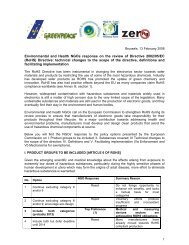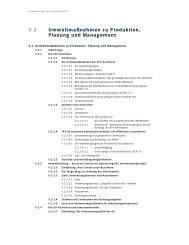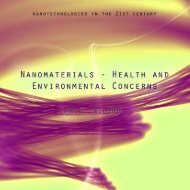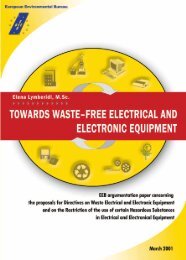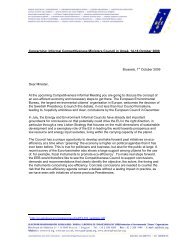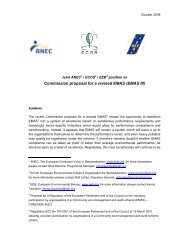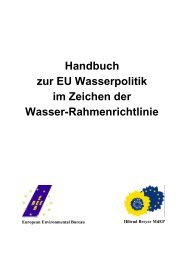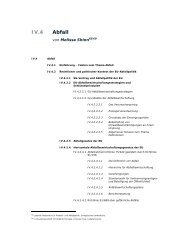Eu Mercury phase out in Measuring and Control Equipment - EEB
Eu Mercury phase out in Measuring and Control Equipment - EEB
Eu Mercury phase out in Measuring and Control Equipment - EEB
Create successful ePaper yourself
Turn your PDF publications into a flip-book with our unique Google optimized e-Paper software.
REPORT FROM THE CONFERENCE “EU MERCURY PHASE OUT IN MEASURING AND CONTROL EQUIPMENT”Arguments for reta<strong>in</strong><strong>in</strong>g mercury devices: More personal <strong>in</strong> touch with patient Accuracy Cost of replacement Problems with cuff sizes for st<strong>and</strong>ard electric.Arguments aga<strong>in</strong>st reta<strong>in</strong><strong>in</strong>g mercury devices: Environmental impact Health <strong>and</strong> Safety issues –spillages Ease of use Flexibility of some electrical equipment to perform multiple functions <strong>and</strong> also recordmeasurements over a period of time.6. The experience of Rezekne Hospital as a mercury-free hospital(Presentation by Jelena Stepule, Rezekne Hospital, Latvia)Rezekne Hospital is a multipurpose emergency medical health care <strong>in</strong>stitution with a total amountof 385 beds. The departments of the hospital provide medical assistance <strong>and</strong> services for more than20 profiles. The Hospital serves residents of Rezekne city <strong>and</strong> region. In some profiles the hospitalalso serves people of other regions of Latgale, e.g. Ludza, Preili <strong>and</strong> Daugavpils. There are morethan 130 000 <strong>in</strong>habitants <strong>in</strong> the service area. Rezekne Hospital is a municipal state <strong>in</strong>stitution <strong>and</strong>employs 77 physicians, 220 nurses, 75 nurse assistants, 73 hospital attendants <strong>and</strong> 71 other workers.There are 30 departments <strong>in</strong> the Hospital: Emergency medical assistance <strong>and</strong> patient receiv<strong>in</strong>g –room, Anesthesia <strong>and</strong> Intensive Care Unit, Necrology Division, children’s department, Gynecologic<strong>and</strong> obstetric department, neurology <strong>and</strong> neurosurgery department, therapy department,traumatology department, Surgery department, Infectious diseases department Hemodialysisdepartment, Pathology department, Sterilization department, Cab<strong>in</strong>et of blood, Pharmacy, Cl<strong>in</strong>icalLaboratory, Ray diagnostic department, Physical medical department.Rezekne Hospital is <strong>in</strong>volved as a pilot hospital <strong>in</strong> the UNDP/GEF project “Demonstrat<strong>in</strong>g <strong>and</strong>Promot<strong>in</strong>g Best Techniques <strong>and</strong> Practices for Reduc<strong>in</strong>g Health Care Waste to Avoid EnvironmentalReleases of Diox<strong>in</strong>s <strong>and</strong> <strong>Mercury</strong>”. 8 The overall objective of the project is to reduce environmentalreleases of diox<strong>in</strong>s <strong>and</strong> mercury by demonstrat<strong>in</strong>g <strong>and</strong> promot<strong>in</strong>g best techniques <strong>and</strong> practices forreduc<strong>in</strong>g <strong>and</strong> manag<strong>in</strong>g health care waste <strong>in</strong> a number of countries <strong>and</strong> regions. In the framework ofthe project the improvement of the waste management (collection, treatment <strong>and</strong> disposal) will beimplemented <strong>in</strong> the hospital as well as the manual for the personnel will be developed <strong>and</strong> tested.The hospital switched to mercury free thermometers three years ago. <strong>Mercury</strong> sphygmomanometersare not <strong>in</strong> use s<strong>in</strong>ce 1998 - 2000 (<strong>and</strong> this refers to most of the hospitals <strong>in</strong> Latvia).Problems with mercury use: <strong>Mercury</strong> evaporates at room temperature with a rate of 0.002 mg of 1cm 2 surface with<strong>in</strong> 1hour <strong>and</strong> the vapor has no color <strong>and</strong> fragrance. In the case of breakage the harmful substances (<strong>in</strong> the shape of small balls) are difficult tocollect. <strong>Mercury</strong> is harmful to the environment <strong>and</strong> toxic to the body. While <strong>in</strong> the room it slowlyevaporates. In humans the effects of <strong>in</strong>halation may occur even after several years.8 http://www.gefmedwaste.org/article.php?list=type&type=330



